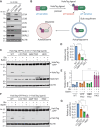Blocking autophagosome closure manifests the roles of mammalian Atg8-family proteins in phagophore formation and expansion during nutrient starvation
- PMID: 39694607
- PMCID: PMC12013414
- DOI: 10.1080/15548627.2024.2443300
Blocking autophagosome closure manifests the roles of mammalian Atg8-family proteins in phagophore formation and expansion during nutrient starvation
Abstract
Macroautophagy/autophagy, an evolutionarily conserved cellular degradation pathway, involves phagophores that sequester cytoplasmic constituents and mature into autophagosomes for subsequent lysosomal delivery. The ATG8 gene family, comprising the MAP1LC3/LC3 and GABARAP/GBR subfamilies in mammals, encodes ubiquitin-like proteins that are conjugated to phagophore membranes during autophagosome biogenesis. A central question in the field is how Atg8-family proteins are precisely involved in autophagosome formation, which remains controversial and challenging, at least in part due to the short lifespan of phagophores. In this study, we depleted the autophagosome closure regulator VPS37A to arrest autophagy at the vesicle completion step and determined the roles of mammalian Atg8-family proteins (mATG8s) in nutrient starvation-induced autophagosome biogenesis. Our investigation revealed that LC3 loss hinders phagophore formation, while GBR loss impedes both phagophore formation and expansion. The defect in membrane expansion by GBR loss appears to be attributed to compromised recruitment of ATG proteins containing an LC3-interacting region (LIR), including ULK1 and ATG3. Moreover, a combined deficiency of both LC3 and GBR subfamilies nearly completely inhibits phagophore formation, highlighting their redundant regulation of this process. Consequently, cells lacking all mATG8 members exhibit defects in downstream events such as ESCRT recruitment and autophagic flux. Collectively, these findings underscore the critical roles of mammalian Atg8-family proteins in phagophore formation and expansion during autophagy.Abbreviation: AIM: Atg8-family interacting motif; ADS: Atg8-interacting motif docking site; ATG: autophagy related; BafA1: bafilomycin A1; CL: control; ESCRT: endosomal sorting complex required for transport; FACS: fluorescence activated cell sorting; GBR: GABARAP; GBRL1: GABARAPL1; GBRL2: GABARAPL2; GBRL3: GABARAPL3; HKO: hexa-knockout; IP: immunoprecipitation; KO: knockout; LDS: LC3-interacting-region docking site; LIR: LC3-interacting region; mATG8: mammalian Atg8-family protein; MIL: membrane-impermeable ligands; MPL: membrane-permeable ligands; RT: room temperature; Stv: starved; TKO: triple-knockout; TMR: tetramethylrhodamine; UEVL: ubiquitin E2 variant-like; WCLs: whole cell lysates; WT: wild-type.
Keywords: Autophagosome closure; ESCRT; LIR; The mammalian Atg8 family of proteins; membrane expansion; phagophore formation.
Conflict of interest statement
No potential conflict of interest was reported by the author(s).
Figures






References
Publication types
MeSH terms
Substances
Grants and funding
LinkOut - more resources
Full Text Sources
Other Literature Sources
Research Materials
